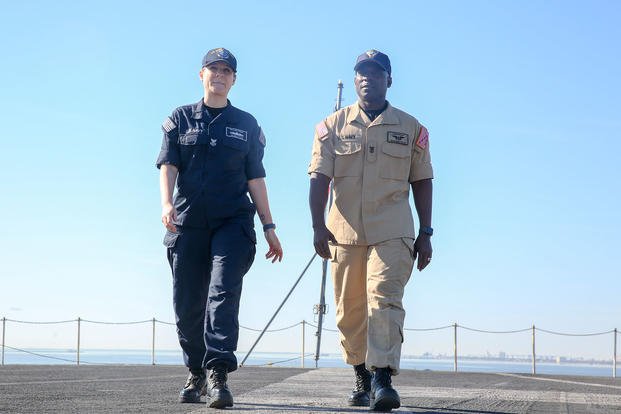The Navy is a step closer to issuing new lightweight flame-resistant coveralls to sailors on ships, replacing the unpopular, heavier version currently worn in the fleet.
One hundred sailors and officers will test the two-piece flame-resistant organizational clothing later this year, officials announced Monday. The uniform has a similar design to the Type III working uniform worn now, but the fabric is not as heavy.
It also comes in traditional Navy colors -- blue for E-6s and below and khaki for chiefs and officers -- which surveys show sailors prefer to the working uniform woodland pattern they currently wear.
Like the Type IIIs, the new uniform design features blouses and trousers in a new flame-resistant material. Sailors in some fields will still have the option of wearing flame-resistant coveralls if they choose. Unlike the coveralls, though, this prototype is authorized to be worn off the ship.
"The best part is that we'll be able to transit from the ship and run errands in the two-piece," Yeoman 1st Class Kelly Pyron, a test participant, said in a release announcing the new wear tests. "Having one standard underway and in-port across the board will be much more convenient."
The Navy has been on the hunt for new flame-resistant uniform options since the old blue camouflage uniforms were banned from ships years ago after tests found them to be highly combustible. Officials found that sailors like the functionality of their two-piece working uniforms but wanted a fabric that would stay cooler while working on a ship.
Sailors will also have the option of removing their blouse in some conditions, pairing their trousers with a black moisture-wicking, flame-resistant undershirt that's still being developed. That's easier than folding down the tops of coveralls, U.S. Fleet Forces Fleet Master Chief Rick O'Rawe, who participated in a wear test, said in the release.
"Leaders are listening to the fleet when it comes to this design," he said. "... This is going to be something that's safe, easy to maintain, and doesn't require half-masting of coveralls when it's hot or having to change clothes every time you leave the ship."
Nearly 200 people have tested the new uniform so far aboard ships, submarines and in aircraft between May and September. Navy leaders have also collected feedback from uniform surveys that were completed by about 1,700 sailors.
Once it's approved, sailors won't have to pay for the new uniform, officials said. That's not likely to happen until about 2021 though, Navy Times reported, since it'll take time to make and field the uniform.
Sailors and officers participating in the next round will be tasked with seeing how well the uniform performs when washed and worn without ironing it first.
-- Gina Harkins can be reached at gina.harkins@military.com. Follow her on Twitter @ginaaharkins.















